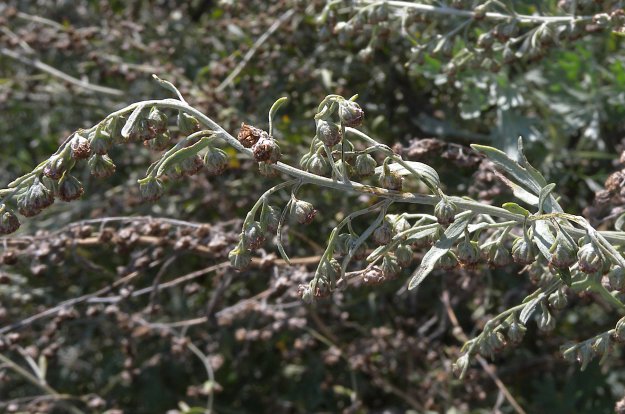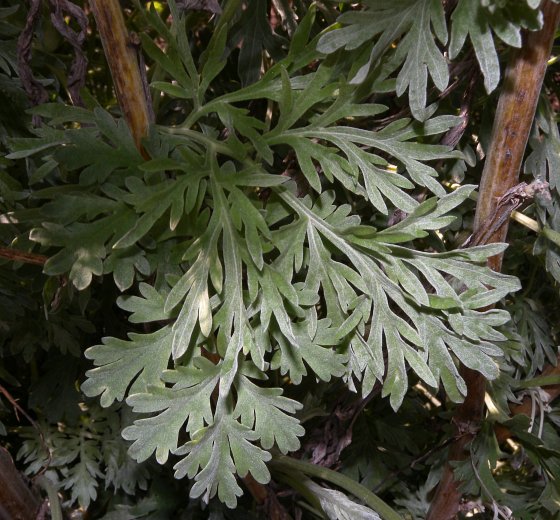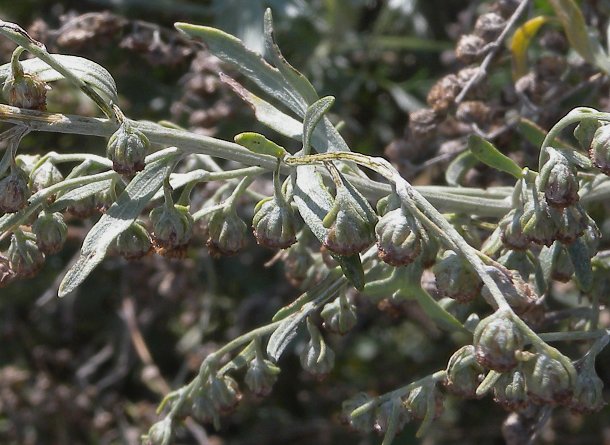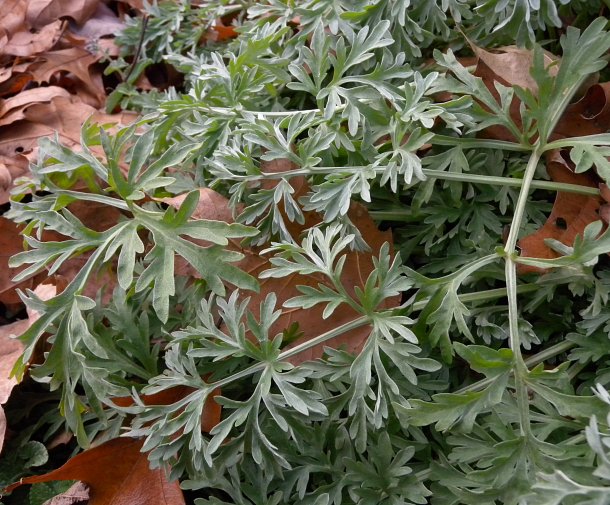
Secondary leafy bracts also occur at the bases of the peduncles on the secondary rachises; these secondary bracts are similar to the primary leafy bracts, except they are smaller in size. Both the primary and secondary rachises of the panicles are grayish green to nearly white and moderately to densely canescent; they are flat or slightly concave along their upper sides and rounded along their lower sides. The nodding flowerheads are 3-5 mm. across and 2-3 mm. tall; they are subgloboid in shape. Each flowerhead has 20-40 perfect disk florets that are surrounded by 10-20 pistillate disk florets; both types of florets are fertile. The florets are seperated by abundant silky hairs that originate from the receptacle. The tiny corollas of these florets are tubular in shape and 5-lobed along their upper rims. Overall, the appearance of these florets is yellowish brown. Along the sides of each flowerhead, there are small appressed phyllaries (floral bracts) in several overlapping series; these floral bracts are whitish green, densely canescent, and oblong to ovate in shape. The flowerheads have short curved peduncles that are whitish green and densely canescent. The blooming period occurs from mid-summer to early autumn, lasting 2-3 weeks for a colony of plants. The florets are cross-pollinated by the wind. Afterwards, the florets are replaced by small achenes. Mature achenes are 0.5–1 mm. long, narrowly oblongoid-oblanceoloid in shape, and light brown; they lack tufts of hair. The root system consists of a taproot up to ½" across. This plant reproduces by reseeding itself.

Cultivation: The preference is full or partial sun, moist to dry-mesic conditions, and soil containing loam, clay-loam, or some gravel. The soil should be well-drained. The size of individual plants can be highly variable depending on their age, moisture conditions, and soil fertility. For a herbaceous wormwood species (Artemisia), Absinthe tends to be long-lived.
Range & Habitat: Naturalized populations of Absinthe can be found in NE Illinois and scattered counties elsewhere, where it is relatively rare (see Distribution Map). All of these naturalized plants have escaped from cultivation. Absinthe was introduced into North America from Europe as an ornamental and medicinal plant. It is still cultivated occasionally in herb gardens today. In North America, this plant is more common in the northern plains of the United States and south-central Canada, where it is regarded as a weed of pastures. Habitats include pastures, sunny fence rows, gravelly areas along railroads, old homestead sites, and waste areas. Habitats with a history of disturbance are strongly preferred. In Illinois, Absinthe has difficulty to competing with taller native plants in natural areas.

Faunal Associations: Several species of aphids are known to feed on Absinthe (Artemisia absinthium); many of these species originated from Europe. Examples include such species as Coloradoa absinthii, Coloradoa angelicae, Coloradoa artemisiae, Macrosiphoniella absinthii (Absinthe Aphid), and other Macrosiphoniella spp. (Blackman & Eastop, 2013; Robinson & Bradley, 1965). Other insects that feed on wormwood species (Artemisia spp.) include Aphis middletonii(Erigeron Root Aphid), larvae of the leaf-miner fly Calycomyza artemisiae (Wormseed Webworm), larvae of the Gelechiid moth, Scrobipalpula artemisiella (Wormseed Webworm), and larvae of the Tortricid moths Eucosma agricolana and Phaneta dorsiatomana (Hottes & Frison, 1931; Spencer & Steyskal, 1986; Marcovitch, 1916; Miller, 1987). Some grasshoppers feed on these plants as well, including Hesperotettix viridis (Meadow Purple-striped Grasshopper), Hypochloa alba (Cudweed Grasshopper), and Melanoplus angustipennis (Narrow-winged Sand Grasshopper); see Vickery & Kevan (1985). Because the foliage of Absinthe is aromatic and bitter, it is not preferred as a source of food by herbivorous mammals. However, cattle and other domesticated livestock will feed on the foliage of Absinthe if little else is available. The consumption of a large quantity of foliage is potentially harmful as it contains the neurotoxin, thujone.

Photographic Location: An herb garden at Meadowbrook Park in Urbana, Illinois.
Comments: Absinthe (Artemisia absinthium) has been used to flavor an alcoholic liquor by the same name. Excessive consumption of this liquor has the potential to cause toxic effects and its use in some countries has been banned. Absinthe is similar in appearance to several other wormseed species (Artemisia spp.); both native and non-native species are present in Illinois. A native species that occurs in sandy areas, Beach Wormwood (Artemisia campestris), can be distinguished by the longer length and narrowness of the lobes of its leaves, the sterile florets in the center of its flowerheads, and the lack of villous hairs on the receptacle of its flowerheads. The presence of the last characteristic (villous hairs on the receptacles of the flowerheads) distinguishes Absinthe from all other wormseed species in Illinois, except for Prairie Sagebrush (Artemisia frigida). Prairie Sagebrush has smaller leaves with more narrow lobes (1 mm. across or less) than Absinthe, while its flowerheads are slightly larger in size (5-6 mm. across and 3-5 mm. tall). It is primarily a western species that is rarely found in Illinois.